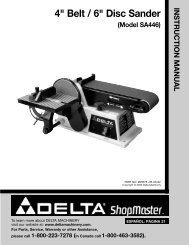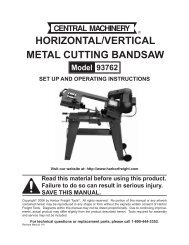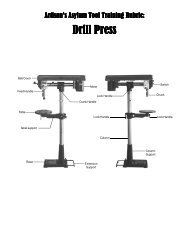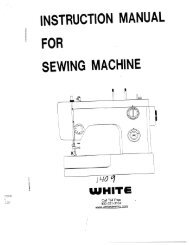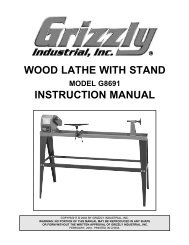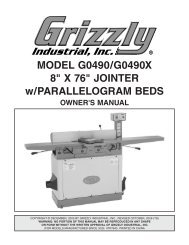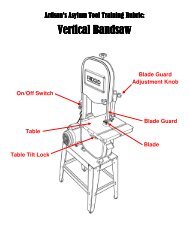Create successful ePaper yourself
Turn your PDF publications into a flip-book with our unique Google optimized e-Paper software.
SPECIFIC SAFETY RULES<br />
• AVOID AWKWARD OPERATIONS AND HAND<br />
POSITIONS where a sudden slip could cause your hand<br />
to move into the blade. ALWAYS make sure you have<br />
good balance.<br />
• ALLOW THE MOTOR TO COME UP TO FULL SPEED<br />
before starting a cut to avoid binding or stalling.<br />
• REPLACEMENT PARTS. All repairs, whether electrical<br />
or mechanical, should be made by a qualified service<br />
technician at an authorized service center.<br />
• WHEN SERVICING use only identical <strong>Ridgid</strong> replacement<br />
parts. Use of any other parts may create a hazard or cause<br />
product damage.<br />
• DIRECTION OF FEED. Feed work into a blade or cutter<br />
against the direction or rotation of the blade or cutter<br />
only.<br />
• BLADE COASTS AFTER TURN OFF.<br />
• BE SURE THE BLADE PATH IS FREE OF NAILS. Inspect<br />
for and remove nails from lumber before cutting.<br />
• KEEP HANDS AWAY FROM CUTTING AREA. Do not<br />
hand hold pieces so small that your fingers go under<br />
the blade guard. Do not reach underneath work or in<br />
blade cutting path with your hands and fingers for any<br />
reason.<br />
• NEVER CUT MORE THAN ONE PIECE AT A TIME or<br />
stack more than one workpiece on the saw table at a<br />
time.<br />
• FIRMLY CLAMP OR BOLT your saw to a stable, level<br />
workbench or table. The most comfortable table height<br />
is approximately waist height.<br />
• DO NOT FEED THE MATERIAL TOO QUICKLY. Do not<br />
force the workpiece against the blade.<br />
• USE ONLY CORRECT BLADES. Use the right blade size,<br />
style and cutting speed for the material and the type of<br />
cut. Blade teeth should point down toward the table.<br />
• BEFORE MAKING A CUT, BE SURE ALL ADJUSTMENTS<br />
ARE SECURE.<br />
• ALWAYS SUPPORT LARGE WORKPIECES while cutting<br />
to minimize risk of blade pinching and kickback. Saw may<br />
slip, walk or slide while cutting large or heavy boards.<br />
• DO NOT REMOVE JAMMED CUTOFF PIECES until<br />
blade has stopped.<br />
• NEVER START THE TOOL when the blade is in contact<br />
with the workpiece.<br />
• NEVER TOUCH BLADE or other moving parts during<br />
use.<br />
• BEFORE CHANGING THE SETUP, REMOVING<br />
COVERS, GUARDS OR BLADES, unplug the saw<br />
and remove the switch key.<br />
• HOLD THE WORKPIECE firmly against the saw table.<br />
• TO AVOID ACCIDENTAL BLADE CONTACT, minimize<br />
blade breakage, and provide maximum blade support,<br />
always adjust the blade guide assembly to just clear the<br />
workpiece.<br />
• KEEP BLADES CLEAN, SHARP, AND WITH SUFFICIENT<br />
SET. Sharp blades minimize stalling and kickbacks.<br />
• ALWAYS TURN OFF SAW before disconnecting it to<br />
avoid accidental starting when reconnecting to a power<br />
source.<br />
• DO NOT OPERATE THIS TOOL WHILE UNDER<br />
THE INFLUENCE OF DRUGS, ALCOHOL OR ANY<br />
MEDICATION.<br />
• STAY ALERT AND EXERCISE CONTROL. Watch what<br />
you are doing and use common sense. Do not operate<br />
tool when you are tired. Do not rush.<br />
• MAKE SURE WORK AREA HAS AMPLE LIGHTING to<br />
see the work and that no obstructions will interfere with<br />
safe operation BEFORE performing any work using your<br />
saw.<br />
• THE BLADE GUIDES HAVE BEEN PRESET AT THE<br />
FACTORY. These settings are functional for some<br />
applications. We recommend that you check and adjust<br />
blade guide settings before first use of your saw. Refer to<br />
“Adjusting thrust bearings, blade guide support, and<br />
blade guides” procedures explained in the adjustments<br />
section of this operator’s manual.<br />
• SAVE THESE INSTRUCTIONS. Refer to them frequently<br />
and use them to instruct other users. If you loan someone<br />
this tool, loan them these instructions also.<br />
WARNING:<br />
Some dust created by power sanding, sawing, grinding, drilling, and other construction activities contains chemicals<br />
known to cause cancer, birth defects or other reproductive harm. Some examples of these chemicals are:<br />
• lead from lead-based paints,<br />
• crystalline silica from bricks and cement and other masonry products, and<br />
• arsenic and chromium from chemically-treated lumber.<br />
Your risk from these exposures varies, depending on how often you do this type of work. To reduce your exposure<br />
to these chemicals: work in a well ventilated area, and work with approved safety equipment, such as those dust<br />
masks that are specially designed to filter out microscopic particles.<br />
4



